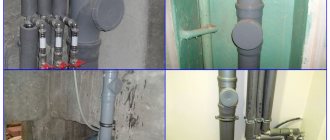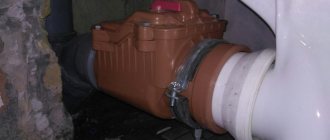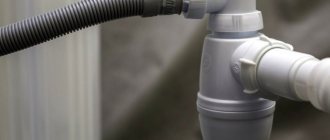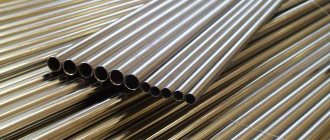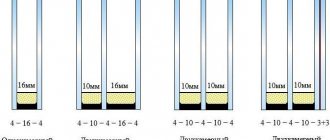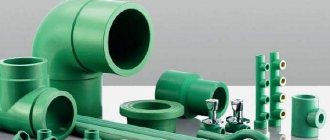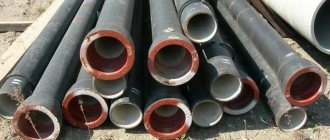One of the important elements of drainage systems is a gate valve for sewerage. Standard shut-off valves cannot cope with such systems, since the fluid being moved is too thick and contains a lot of foreign inclusions.
As a valve, it is necessary to use more efficient devices that can cope with heterogeneous liquids or pulp. Slide valves have proven themselves well in sewerage systems and other types of communications. Let's take a closer look at them.
Definition and purpose
Plastic valves for regulating and blocking sewer flow.
A sewer plug is a plate or sphere that blocks the internal section of the pipeline.
Gate valves are fittings with shut-off valves in the form of a petal, wedge or knife to regulate internal pressure or completely block the flow. They are installed mainly during the construction of sewerage systems on citywide lines, risers between floors, and pressure stations.
Protective and temporary plugs for plastic lines are installed to cover lines that are temporarily not in use and inspection hatches. They look like glasses with a smooth surface and are placed in the holes of bends or tees. The outlet must be equipped with a rubber gasket.
Elements are selected from the material that was used for the production of the main pipes - polypropylene and PVC.
Valves with mechanical control are mounted at connection points of individual lines. On autonomous mains, adjustable valves are installed in external areas in front of the entrance to the septic tank.
Complex devices with automatic locking and regulation are equipped with an electric drive and devices for monitoring the force of internal pressure. They are used to create the required pressure inside the pressure sewer network.
The installation of shut-off elements for sewer networks is carried out as planned or urgently to completely or partially block a branch or stop the movement of solids.
Valves classification
Gate valve with flange joint
According to the type of fastener, shut-off valves are divided into the following types:
- valves with flanged joints;
- rubber gasket plugs;
- threaded parts;
- welded plugs.
The latter are used to permanently block metal pipelines.
In addition to shut-off elements mounted outside sewer pipes, mesh filters are used that allow water to pass through and stop the movement of solid waste through the pipeline. To disconnect a separate riser from the general sewer line, pneumatic plugs are installed.
As a valve for external and internal sewage systems, membrane-type check valves made of polymers are often used on a plastic pipe. They can be positioned horizontally or vertically. The locking element is a membrane with a rubber seal; access for maintenance work is provided through an inspection hatch.
Gate valves are used to increase or decrease the permeability of sewer pipes. The difference lies in the complete tightness of shutting off the internal part of the highway if necessary. For sewerage, such a device is preferable, since it can block or limit the flow of homogeneous liquid and various substances with solid inclusions or gaseous streams.
A cast iron or steel gate valve is installed on both metal and plastic pipes.
Operating principle of the gate mechanism
The mechanism includes:
- frame,
- gate,
- stand,
- sealing elements,
- stuffing box seal assembly.
The force by which the movement of the gate is regulated is transmitted through the rod.
Tightness is ensured by strong pressing of the gate element to the seals by the pressure of the moving medium. The design of the gates may include a retractable or non-retractable stem. Fixed stem is widely used when installing gate valves in confined spaces.
Frame
Gate valve bodies can be cylindrical or rectangular. They can be all-metal or prefabricated (for example, welded). The housings can be equipped with a removable bottom cover and a through gate. The housings are made of high-strength cast iron, non-ferrous metal or alloy steel.
The material from which the valve is made has a direct impact on its resistance to aggressive environments. Thus, cast iron elements are less resistant to the effects of:
- diesel fuel,
- motor oil,
- gasoline,
- industrial oil.
In order to reduce the cost of the valve and increase its resistance to aggressive environments, combined valves are used - the body is made of cast iron, and the gate is made of alloy steel. If cast iron is exposed to an aggressive environment, it is coated with epoxy resin for preservation purposes. In some cases, in aggressive environments, gate valves with bodies made of high-strength PVC are used.
Knife
It can be made from a thick rolled plate having sealing
parallel elements. The knife element has a through hole obtained by drilling. The diameter of the hole should be equal to the diameter of the pipe to which the gate is attached.
The gate element may have a pointed edge, which may be at an angle to the hole being closed or close it directly. This allows you to separate the elements of the gates:
- for knife
- and guillotine.
The sharpened element of the knife allows you to easily close holes through which a viscous or solid medium passes. The possibility of closing the pipeline opening as quickly as possible depends on the size of the sharpening.
High-strength alloy steel is used to make knives. The knife is polished, ensuring the easiest possible sliding along the sealing elements and the tightest possible connection to the edge of the seal or pipeline. High-quality polishing helps prevent braking or jamming when blocking flows of media containing a large number of solid inclusions.
Seals
Two types of seals can be used: metal, synthetic components.
- In the petrochemical industry, nitrile rubber is used as a sealing material.
- When working with oils and fuels at low temperatures, a sealant based on a rubber mixture and SKN is well suited.
- Silicone-based sealants are widely used in the pharmaceutical and food industries.
The seal ensures a tight seal on the top of the device. Its padding consists of cotton fiber, synthetic polymaterials, and graphite-containing material.
Types of connection to pipelines
The devices are attached to pipelines by:
- flanged,
- wafer,
- welding connection.
Strengthening the tightness of the gate with a wafer or flange connection is enhanced by means of special gaskets.
Design features of gate valves
Slide valves are used for reliable sewer shutoff: they are capable of holding high pressure. The type of product is determined by the shape of the locking part, and there are two types. Wedge designs have a main locking part, as well as device seats with wedge-shaped seals. When choosing this type of fittings, it is important to take into account the diameter of the product - it must coincide with the cross-section of the pipe sections.
The advantage of a wedge valve is that it can be serviced without particularly complex actions. A shut-off block with forward or return movement at right angles to the wastewater flow blocks or opens the path for its movement. When the inside of the pipe is completely closed, the locking wedge deforms due to the applied load, which increases the tightness. However, wedge fittings cannot withstand intense flows and may fail due to corrosion.
Gate valves with one or two knives are more reliable. They are used in large cross-section pipelines - from 250 mm, steel or cast iron. At enterprises they are equipped with an electric drive or use pneumatic and hydraulic adjustment devices.
Unlike a wedge, a gate knife has a sharp edge. Sometimes it is performed in the form of a guillotine. Such parts allow you to quickly shut off the flow of even viscous wastewater containing many foreign inclusions.
There are two types of gate valves for manual control - retractable and non-retractable. The first include devices in which the spindle is completely pulled out of the pipeline to open the duct. Non-retractable devices include devices with a revolving and ball mechanism.
Areas of use
When they say “sewer valve,” they mean not so much the design as the method of using this device. However, the effectiveness and reliability of these devices are appreciated in various industries or communication systems:
- food industry;
- mining enterprises;
- technological lines of chemical plants;
- pulp and paper mills;
- oil industry.
This popularity is explained by reliable, trouble-free operation with pulp, suspensions or liquids of heterogeneous composition. Slide valves are used in different technological lines:
- water intake;
- sewage or stormwater treatment plants;
- in coal mining technology;
- in hydrometallurgy.
The units are capable of working with liquids containing different components:
- sewage waste;
- rainwater runoff;
- pulp;
- a mixture of ash and water;
- sludge (sludge, dirty wastewater from technological lines, etc.);
- coal pulp;
- cooling water carrying scale, etc.
As part of drainage systems, a gate valve is most often found in a sewer well. It serves external sections of pipelines, distributing and regulating the volume of wastewater. However, there are also well-free designs. They are constantly immersed in liquid, so they are equipped with a specially designed spindle.
The use of gate valves for drinking water networks is prohibited, since the valve extends outside the pipeline.
Specifications
The list of technical parameters of gate valves contains the following items:
body material - carbon steel, cast iron, stainless steel;
- connecting element - flange or welded;
- type of control (drive) - manual, gear, electric, pneumatic, electric-hydraulic;
- liquid pressure - up to 10 MPa;
- maximum ambient temperature - up to +425°;
- The minimum temperature allowed during operation is -60°.
There are designs designed to work in difficult conditions. Their parameters exceed normal values. There are also devices for use in private (stand-alone) systems. For example, a sewer valve 110 on a plastic pipe. It differs from standard installations in all respects, especially in size. To install such a valve, you do not need a well if the valve is located in the basement of the house. For external areas, it is necessary to fully equip the shutter in an insulated plastic well with a minimum diameter of 1 m.
Also read: Sanitary protection zone of sewerage treatment facilities: what is a sanitary protection zone, a security zone
Criterias of choice
When choosing a locking device, pay attention to the following points:
- method of adjustment and control;
- compliance with the working environment in the highway;
- pipe section;
- terms of Use;
- manufacturer's brand.
For example, there are gate valves that show excellent efficiency at high temperatures, up to 400 degrees, but can fail in cold environments.
The cross-section of gate valves varies, from 5 to 220 cm, and depends on the area of application and the diameter of the pipes. The operating pressure that such devices can withstand should not exceed 60 atmospheres.
What is a gate
A standard sewer valve does not give the desired effect. Its design does not allow completely blocking the passage of pipelines, since the transported liquid is heterogeneous. It is filled with solid particles, organic matter, and foreign objects. A different type of closure device is required that can handle suspended matter or slurry. To solve the problem, a gate valve was developed - a valve on a sewer pipe, the action of which is based on a different principle.
The main element of the device is a flat cutting element that moves in a horizontal plane. Technical name: horizontal sliding gate. When it is necessary to block the lumen of the pipeline, it moves and cuts off the pipe, cutting off any organic particles or other inclusions that come across. The chimney valve works in a similar way.
The sewer gate works only in this way, but there are other designs. Ventilation systems use a rotary damper that moves around a transverse axis. In sewer systems, this design is useless, so it is not used.
The force to move the blade plate is transmitted through the rod. It is driven in different ways, manually or electrically. For example, a gate valve in a sewer well with a diameter of 1 m is too difficult to move manually, so powerful electric motors are used. There are installations with one or two knives. The former are more rigid, but the latter provide increased tightness and reliable shutoff. An important design feature is the removal of the kinetic scheme beyond the pipe cross-section. This requires the construction of special tanks to accommodate the drive. If a well is made with a gate valve, the sewage system must be of the non-pressure type. For pressure lines, it is necessary to use reinforced models designed for high pulp pressure.
The feed system does not come into contact with the fluid being moved. This allows you to increase the service life of the device and makes valve maintenance or repair more efficient.
